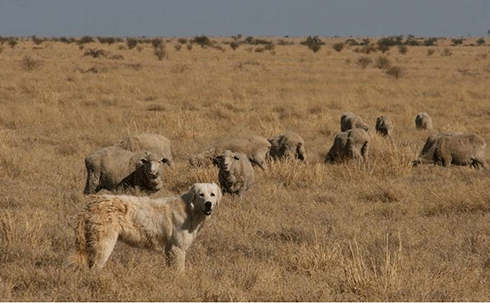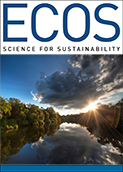
|
Published: 22 December 2014
Can farmers live with dingoes?
ECOS has been exploring the ecological value of dingoes and other apex predators within ecosystems, as part of a wider debate about whether such predators should be culled or conserved in areas where they come into conflict with humans and human property. Now we ask, is it possible for dingoes and livestock grazing to co-exist?
In Montana, at the northern edge of the American Rocky Mountains, Range Riders have been helping reduce conflict between wolves and livestock since 2008.
Wolves, reintroduced into the adjacent Yellowstone National Park in 1995, have recolonised the 607,000-ha watershed of Blackfoot Valley. The Range Riders, funded by a consortium of environment groups and government, patrol livestock herds across 20,000–24,000 hectares. Often it is simply their physical presence that deters wolves, but occasionally they also haze or harass animals that show an interest in the livestock.
In Australia, on the other hand, the dingo has been virtually eliminated from the south-east of the country. In fact there are very few safe places left for the dingo in Australia.
On grazing lands they are killed to reduce predation on sheep and cattle. On conservation reserves, including many national parks, they are killed alongside foxes to conserve native animals, primarily small-to-medium sized mammals. Under federal, state and industry-led wild-dog control programs, dingoes are poisoned (including aerial 1080 baiting), trapped, and shot on public and private land, although the degree of control varies between the sheep zone and the cattle zone.
There is also the dingo fence – at over 5000 km, the longest continuous fence on earth – designed to exclude dingoes from the sheep-grazing lands of south-eastern Australia.
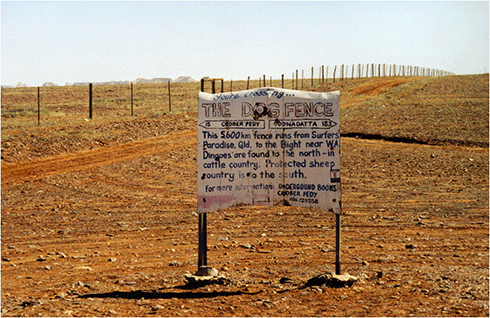
|
|
The dingo fence runs for over 5000 km from the Darling Downs, near Dalby in southern Queensland, west though thousands of kilometres of arid land ending on the cliff tops of Fowlers Bay on the Nullarbor Plain in South Australia. It divides the cattle grazing districts on the northern side from sheep grazing districts on the southern side. Credit: Schutz (CC-BY-SA-3.0 via Wikimedia Commons)
|
There is mounting evidence that dingoes play a key role in maintaining native ecosystems, largely by preying on introduced ‘mesopredators’, such as feral cats and foxes. They also prey on herbivores – for example, kangaroos and rabbits – that can degrade habitat by overgrazing if their densities are very high.
Australia’s first ‘predator-friendly’ pastoral network is being coordinated by Dr Arian Wallach of Charles Darwin University. It includes Evelyn Downs, a 2300-square-kilometre cattle station in northern South Australia. Dr Wallach and her partner Adam O’Neill managed Evelyn Downs for two years between 2012 and 2014. During that time, dingoes were protected from poaching and water was made available at all times (dingoes situate their territories around permanent water sources).
‘In our time on the station, calf losses to dingo predation were minor compared to other causes of mortality and tended to decline,’ says Dr Wallach.
‘Nearly all the calf predation events occurred in the first six months of our tenure. So we saw an improvement and this is something that other predator-friendly cattle station managers we’re in contact with have also reported – that generally, by leaving dingoes alone, they have much fewer problems with them.’
One explanation for the reported decline in stock losses is the territorial nature of dingoes and their ability to form stable, enduring pack structures.
‘When dingoes are left alone, their populations tend to stabilise. This is because they seem to have the ability to regulate their own densities,’ Dr Wallach explains.
‘Like other large canids, such wolves and coyotes, dingoes form extended family groups and these “packs” hold territories. Within these territories, each pack only has one breeding pair – the mother and father.
‘The “kids” stay at home for a long time and help rear the other pups of their parents. You can have a single individual female wolf holding a territory and being matriarch of her pack for up to 14 years.’
Killing dingoes, on the other hand, can disrupt the pack structure and trigger population increases: every female can reproduce and form pairs, and the pairs don’t hold territory.
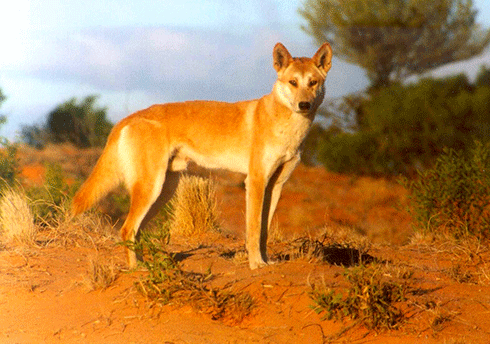
|
|
A dingo in south-east Queensland. Credit: huntersaurus under CC BY-NC-ND 2.0
|
Recent research backs the idea that dingoes can be in equilibrium with livestock grazing. A joint University of Adelaide–University of Tasmania study investigating trade-offs between livestock density, kangaroo abundance, calf losses and dingo control concluded that ‘top-down herbivore [kangaroo] control by dingoes should allow cattle pastoralists to profit from conservative stocking densities while reducing the risk of pasture over-utilisation’.
But research has its challenges. According to Dr Wallach, at least 2000 square km is needed to establish an ecologically viable study area in the arid zone.
‘Dingoes can have large territories (over 100 sq km in some habitats) and so a large protected zone is required. Once you get smaller than that, poison baiting and shooting on other properties influences what happens on your property.’
While property sizes larger than this are common in rangelands north of the dingo fence, widespread lethal control has made it difficult to collect this kind of data. Dr Wallach would like landowners to work together across property boundaries to protect dingoes over large areas.
Properties where sheep are grazed tend to be smaller, and the damage caused by dingoes much more significant, as sheep, particularly lambs, are vulnerable to predators.
Farmers Andrew and Glenda Bowran run sheep and cattle on Riversdale, a 1214-ha property in hilly country in North East Victoria. In 2006, after 4 years of heavy losses of sheep to wild dog predation, they were at the end of their tether.
‘We were running out sheep,’ says Andrew.
‘The dogs were eating the lambs and killing the adult sheep and it was getting worse. We had 800–900 ewes. We’d go to mark the lambs [put ear tags on them] and one year we only marked 56 lambs out of those ewes. Then when we went to shear those lambs, we had 25, and when we went to wean them we had 10!’
In desperation, having tried aerial baiting and shooting, they purchased and trained 4 Maremmas, a breed of livestock guardian dogs.
If managed correctly, Maremmas and other livestock guardian dogs bond to livestock early in life and come to regard the livestock as part of their pack. Like dingoes, livestock guardian dogs establish territories which they patrol, reducing predation by deterrence rather than direct aggression.
In Australia, they are commonly left to range free across properties, with minimal human contact other than a weekly check-up and refilling of a self-feeder.
‘In the first year we had the Maremmas, up to 70 per cent of our ewes produced lambs that survived, and it’s been the same ever since. We used to get around 100 per cent before the wild dogs came, but I’m content with 70 per cent. It’s better than nothing.’
In Australia, there are few primary producers using guardian dogs. Guardian dogs are more common in free range poultry and goat farming, but are still rare on sheep enterprises. On the larger cattle stations, they are not often used because the vast areas make it impractical to get food to them and check on them regularly.
Dr Linda van Bommel of the Australian National University has written a guide to the use of livestock guardian dogs for the Invasive Animals Cooperative Research Centre. She believes that the reasons for low uptake among sheep growers are primarily cultural.
‘In Australia, people don’t understand how guardian dogs work,’ says Dr Van Bommel.
‘They are familiar with border collies and kelpies, but these work very differently and you can’t trust them with livestock unsupervised. So, many people tend to think that any dog with sheep is bad.
‘There is also resistance to change – the view that baiting has worked in the past so why change how we do things?’
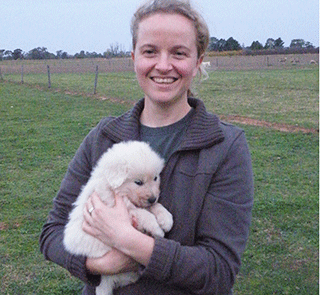
|
|
Linda van Bommel with a Maremma pup. Credit: Linda van Bommel
|
Dr Thomas Newsome of the University of Sydney believes the jury is out on the effectiveness of baiting.
‘I think we need a broader assessment of the effectiveness of current baiting and control strategies. Not in terms of their effectiveness in reducing dingo densities, but their effectiveness in reducing predation by dingoes on the livestock themselves.
‘Some of the studies on this show that low-intensity control is ineffective in reducing dingo densities and stock losses.’
Most farmers want to do right by the environment – it’s just that the economics often don’t add up. Both Dr Newsome and Dr van Bommel want more research to be done on potential gains in productivity from non-lethal control of dingoes.
‘In many areas, kangaroos are the main prey of dingoes,’ says Dr Newsome.
‘If dingoes predate on kangaroos and that results in increased pasture availability for domestic livestock, then that needs to be incorporated into the economics of dingo control.
‘There has been some recent modelling work that suggests that retaining dingoes in some areas could have a net benefit in terms of economic productivity. Modelling gives a good insight but this needs to be tested on the ground.’
Dr van Bommel is interested in exploring evidence that livestock guardians may improve economic productivity by reducing stress levels among livestock. Reduced stress can lead to higher productivity, whether this is better quality wool, or more eggs, or even better quality offspring.
Dr Newsome has recently spent time in the USA and Europe looking at ways in which farmers, livestock and predators can coexist. Examples that have not yet been trialled in Australia include compensation schemes for farmers for stock losses or for expenses involved in implementing predator-friendly management practices.
‘Until you can stand up in front of a room of farmers and sell to them that coexistence will be a more productive and economically viable option, it’s unlikely that a shift will occur,’ he says.


